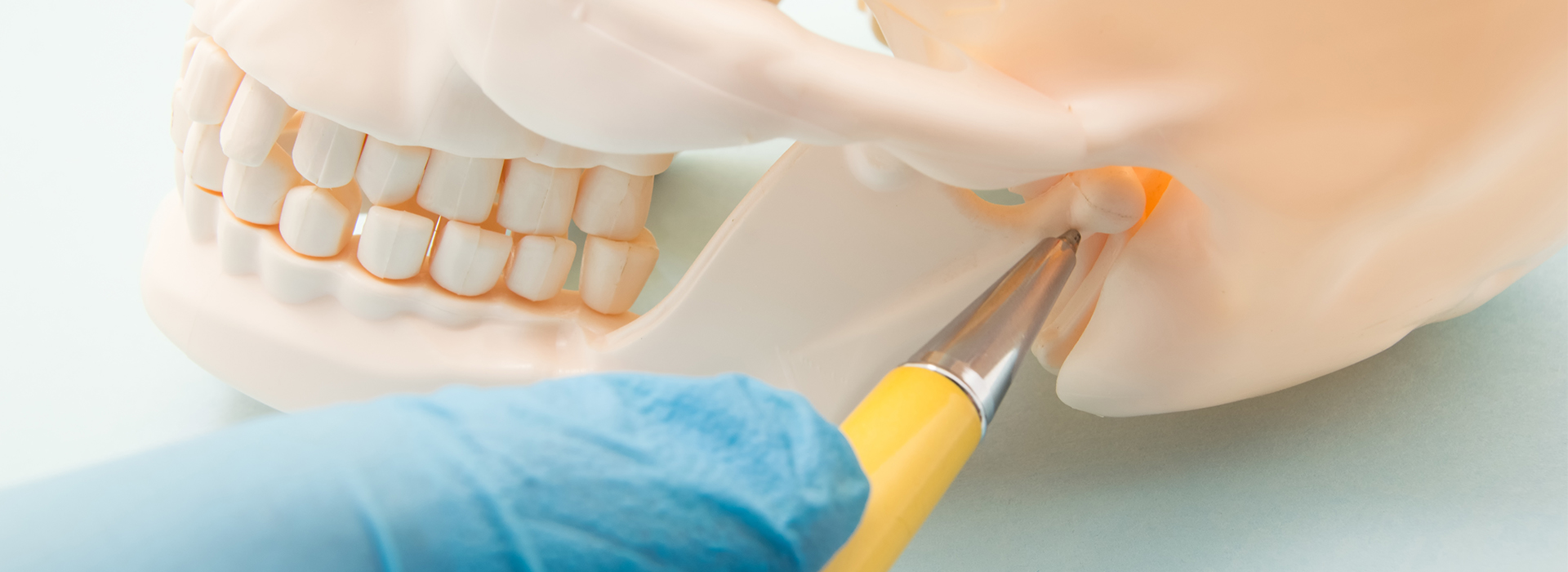Understanding the Jaw’s Hidden Workhorse
The temporomandibular joint (TMJ) is a small but remarkably complex joint that lets your jaw open, close and move side to side. It combines hinge-like motions with sliding actions, which is why even minor changes to the joint, its disc, or surrounding muscles can produce noticeable discomfort or limit function. When this system becomes irritated or misaligned, patients may experience a cluster of symptoms that fall under the umbrella of TMJ disorders.
TMJ disorders are common: millions of people encounter jaw pain, clicking, or stiffness at some point in their lives. These conditions are not the same for everyone — some experience brief flare-ups that resolve on their own, while others develop recurring or chronic problems that interfere with daily activities like eating, speaking, and sleeping. Because the joint works closely with the muscles and nerves of the head and neck, symptoms often cross over into other regions, which can make identifying the root cause challenging without a careful evaluation.
One reason the TMJ is difficult to treat is its functional complexity. The joint contains a soft articular disc that cushions the condyle (rounded end of the lower jaw) and the temporal bone of the skull. When this disc shifts, degenerates, or fails to move smoothly, the mechanics of the entire joint can change. Likewise, persistent muscle tension or changes in bite alignment can place uneven pressure on the TMJ, contributing to pain and dysfunction.
Although the terminology can be confusing, “TMJ” generally refers to the joint itself, while “TMD” (temporomandibular disorders) describes the various clinical issues that affect the joint, muscles, and related structures. Understanding this distinction helps patients and clinicians focus treatment on the specific source of symptoms rather than only addressing surface-level complaints.
Common Causes and Contributing Factors
TMJ problems rarely have a single cause; instead, they emerge from a combination of mechanical, muscular, and systemic factors. Teeth grinding (bruxism) and clenching are among the most frequently observed contributors, since these habits fatigue the jaw muscles and increase pressure on the joint surfaces. Over time, repetitive strain can alter the disc position or lead to muscle pain and inflammation.
Trauma to the jaw or head — such as a direct blow, whiplash, or dental procedures that stress the joint — can trigger or worsen dysfunction. Structural conditions, including arthritis (osteoarthritis or rheumatoid arthritis), can degrade joint cartilage and change how the jaw moves. For some patients, a sudden event precipitates symptoms; for others, the problem develops gradually as multiple small stressors accumulate.
Psychosocial and lifestyle factors also play a role. Chronic stress, anxiety, and poor sleep can increase muscle tension and lead to more frequent clenching, while posture issues may alter how the jaw rests and moves. Hormonal and genetic influences have been proposed in research, but the clinical significance varies between individuals. That’s why a personalized approach to identifying contributing factors is essential for effective care.
Understanding what fuels a patient’s symptoms helps clinicians design targeted therapies that address root causes rather than only masking pain. A thorough assessment will consider habits, medical history, and how daily activities may perpetuate strain on the TMJ system.
Recognizing Symptoms and When to Seek Care
Symptoms of TMJ disorders can be broad, and they often overlap with other conditions. Common red flags include persistent jaw pain or aching around the ears, noticeable jaw stiffness, difficulty opening the mouth fully, and audible popping, clicking, or grating sounds during movement. These signs may be accompanied by headaches, neck and shoulder tension, or a feeling that the jaw is “locked” in an open or closed position.
Some patients report ear-related sensations such as fullness or ringing (tinnitus) even when ear exams are normal, because the TMJ sits close to the structures of the ear and shares nerve pathways. Others notice pain when chewing tough foods, or that their bite feels different than usual. Symptoms that interfere with eating, speaking, sleep, or quality of life warrant a professional evaluation rather than home-only remedies.
It’s reasonable to try conservative self-care for a short period — gentle jaw-stretching exercises, soft foods, and heat or cold packs can reduce acute discomfort. However, if symptoms persist beyond a few weeks, worsen, or are accompanied by neurologic changes (such as numbness or severe imbalance), patients should seek care. Early assessment improves the chances of preventing chronic changes and helps tailor a plan that matches a patient’s needs and lifestyle.
When you visit a dental or medical provider, come prepared to describe the onset, pattern, and triggers of symptoms, as well as any habits like grinding or how stress may affect your jaw. That information often guides the diagnostic steps and speeds the path to effective management.
How TMJ Disorders Are Evaluated
Evaluation begins with a focused clinical exam of the jaw, muscles, and bite. A clinician will look for limits in jaw motion, palpate muscles for tenderness or tightness, and listen for noises during opening and closing. An assessment of the patient’s dental occlusion (how the teeth meet) and posture helps reveal mechanical contributors, while a review of medical history can identify systemic conditions that influence joint health.
Imaging is used selectively to clarify uncertain or persistent problems. Panoramic X-rays, CBCT scans, or MRI each provide different information: X-rays and CBCT reveal bone structure and joint alignment, while MRI is the preferred tool for visualizing the soft articular disc and surrounding soft tissues. These studies are chosen based on the clinical question and after a discussion with the patient about what the images will reveal.
In many cases, a collaborative approach improves diagnostic accuracy. Dentists, oral and maxillofacial specialists, physical therapists with craniofacial expertise, and medical providers may all contribute to a comprehensive evaluation. This multidisciplinary view is particularly valuable for complex or longstanding conditions that touch multiple systems.
Documentation of symptoms over time, including symptom diaries or records of sleep and stress patterns, can also help clinicians track responses to treatment and refine care strategies. The goal is a clear picture of the problem so that interventions target the correct structures and behaviors.
Practical Treatment Options and Long-Term Care
Treatment for TMJ disorders typically follows a stepped approach, beginning with conservative, reversible therapies and progressing to more advanced options only when needed. Initial interventions focus on pain control and reducing harmful forces: jaw rest, behavioral changes to limit clenching, guided relaxation, and a short course of anti-inflammatory measures when appropriate. These steps often reduce acute discomfort and allow the joint to recover.
Oral appliances such as custom night guards or stabilization splints are commonly used to protect teeth, reduce muscle strain, and improve jaw position during sleep. These devices are tailored to the patient’s bite and worn as part of an overall plan that may include home exercises and lifestyle modifications. Physical therapy techniques — including manual therapy, targeted stretching, and posture correction — can relieve muscle tension and improve function for many patients.
>
For cases that do not respond to conservative care, additional interventions may be considered. Injections (for example, corticosteroids or arthrocentesis in specific scenarios) and occlusal rehabilitation or orthodontic adjustments can be helpful for selected patients when structural factors are clear contributors. Surgical options are reserved for well-defined conditions such as severe joint degeneration or persistent internal derangement that fails to improve with other measures.
Long-term management often emphasizes self-care and relapse prevention. Patients benefit from learning to recognize early warning signs of a flare-up, maintaining healthy sleep and stress habits, and continuing prescribed exercises. Regular follow-up allows clinicians to adjust devices, review biomechanics, and intervene early if symptoms reappear. When coordinated by an experienced dental team, such ongoing care helps most patients maintain function and limit the frequency and severity of future episodes.
At Cruzin' Dental, our clinicians take a measured, patient-centered approach to TMJ disorders: we combine careful assessment with conservative therapies and provide referrals to specialists when necessary. If you suspect a TMJ problem or are experiencing persistent jaw pain or dysfunction, please contact us to learn more about evaluation and treatment options. We’re here to help you restore comfort and function with a plan tailored to your needs.




